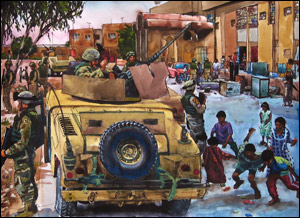
BAGHDAD JOURNAL: Steve Mumford’s watercolors and drawings will be on display at Tufts. |
Art mixes it up with history and politics, peers closely at electronic surveillance, worries about its own usefulness, traipses down the fashion runway, and brings cool stuff back from China and Puerto Rico in exhibitions opening this fall.The subversive power of printmaking is the subject of “DISSENT!” at Harvard’s Fogg Art Museum (32 Quincy St, Cambridge; November 11–February 25), with works including civil-rights activist Sister Corita’s 1969 screenprint proclaiming “BLACK IS BEAUTIFUL,” Richard Serra’s 2004 Stop B S, which plays on the name of our commander-in-chief, Goya’s etchings critiquing late-18th-century society, and expressions of protest printed on armbands, T-shirts, and playing cards.
Also at Harvard, current social conditions and questions about the relationship of art to function have Mexican artist Pedro Reyes pursuing unusual projects that include recent research, in collaboration with Harvard’s Cultural Agents Initiative, into the utility of art objects and processes. Reyes’s first major retrospective, “AD USUM: TO BE SED,” is at the Carpenter Center for Visual Arts and the Sert Gallery (24 Quincy St, Cambridge; October 26–January 5).
During four trips to Iraq in 2003 and 2004, Steve Mumford traveled with Army units to Baghdad and seven other cities, posting his “Baghdad Journal,” an ongoing record of his experiences in the form of drawings and writings, at www.artnet.com. Watercolors and sepia drawings from these travels, as well as portraits of disabled Iraqi War veterans drawn from his 2006 visit to Brooke Army Medical Center, are on view in “BAGHDAD AND BEYOND: DRAWINGS BY STEVE MUMFORD” at Tufts University Art Gallery (40R Talbot Ave, Medford; through November 19). A different war, also captured up-close and personal, is the subject of “HISTORY IN A SHOEBOX: PHOTOGRAPHS FROM THE SPANISH CIVIL WAR, LLEIDA 1936–1939” in the Jewett Art Center at Wellesley College (106 Central St, Wellesley; September 27–October 29), with 20 never-before-seen photos taken by Ramon Rius, a baker from Lérida whose compelling images of the takeover of his Catalan home town by Fascists remained hidden for decades.
Concealed cameras are the stuff of spies, detectives, our government, and even, ubiquitously now, reality TV, where all sorts of folks allow themselves to be taped with their full knowledge. “BALANCE AND POWER: PERFORMANCE AND SURVEILLANCE IN VIDEO ART” at Brandeis’s Rose Art Museum (415 South St, Waltham; September 21–December 17) looks at how artists have used surveillance techniques, from early video pioneers Vito Acconci and Bruce Naumann to current practitioners Julia Scher, Harun Farocki, Jenny Marketou, and others fascinated by issues of control, secretiveness, performance, and paranoia. The Rose is also presenting “CLARE ROJAS: HOPE SPRING IS ETERNAL,” (September 21–April 1) a large-scale installation by a California-based artist whose work looks as if it could be at home in a covered wagon or might have just walked out of the pages of a fairy tale, except that some of the men are naked. Nature and gender are lively actors in Rojas’s complex dramas.